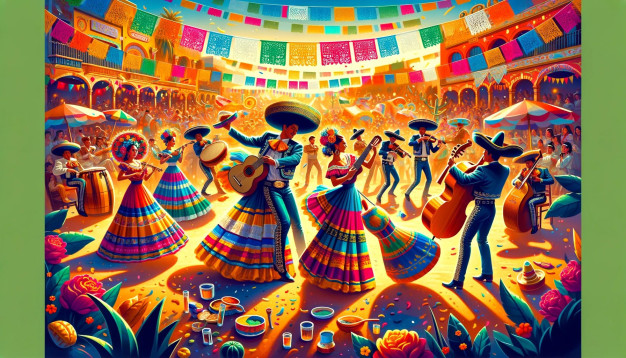Music a Dances in Mexico
Explore the vibrant rhythms and moves defining Mexico's rich musical and dance heritage.

Introduction to Mexican Music and Dance
The Rich Heritage
Mexican music and dance are a tapestry woven with threads of pre-Hispanic, colonial, and modern influences. This vibrant cultural quilt is not just for show; it’s a pulsating part of everyday life that ties Mexicans to their ancestors and fuels contemporary expression.
Regional Diversity
Travel across Mexico, and you’ll find that each state, sometimes each town, dances to the beat of its own drum—literally. The North sways to Norteño, while Mariachi strings resonate from Jalisco, and Veracruz gets lively with Son Jarocho.
Traditional Mexican Music Genres
Mariachi: The Heartbeat of Mexico
Mariachi music is like the guacamole to your tortilla chip—essential. With violins, trumpets, and guitars, it’s the sound of Mexico’s soul, narrating tales of love, country, and revolution.
Norteño: Sounds of the North
Accordions and bajo sextos define Norteño, a genre rooted in the North, with a side of polka influence for good measure. It’s the musical equivalent of a hearty plate of carne asada—robust and satisfying.
Ranchera: Ballads of the Countryside
Ranchera is the soundtrack of the rural heart, crooning about love, patriotism, and nature. If Mariachi is a hearty meal, Ranchera is the fine tequila that warms your chest as you sip it by the campfire.
Son Jarocho: The Rhythmic Blend of Veracruz
Son Jarocho is the mischievous cousin in the family, blending Spanish, indigenous, and African rhythms. It’s like the complex mole sauce—once you’ve had a taste, you’re hooked.
Popular Dance Forms in Mexico
Ballet Folklórico: The Colorful Storytelling Dance
Ballet Folklórico tells Mexico’s history through movement and vibrant costumes. It’s a feast for the eyes, as if the country’s rich tapestry came to life and decided to sashay around in a swirl of colors.
Jarabe Tapatío: National Dance of Mexico
The Jarabe Tapatío is the poster child of Mexican dance, often known as the "Mexican Hat Dance". It’s the dance you think you know—until you see the pros in action, and then it’s a whole new sombrero game.
Danza de los Viejitos: The Dance of the Little Old Men
Danza de los Viejitos is a cheeky dance where performers dress as old men, shuffling and suddenly bursting into energetic moves. It’s like your grandpa suddenly deciding to run a marathon—and winning.
La Danza del Venado: The Deer Dance
La Danza del Venado is a captivating narrative dance representing the hunt of a deer. It’s as intense as watching a telenovela cliffhanger, where you’re rooting for the deer, even though you know the outcome.
The Instruments That Define Mexican Music
Guitarrón: The Bass of Mariachi
The Guitarrón is the plump, deep-voiced backbone of Mariachi. Without this burly stringed beast, Mariachi would be like a taco without salsa—unthinkable.
Vihuela: The High-Pitched Rhythm
The Vihuela brings the high-pitched rhythm that keeps Mariachi bouncing. It’s the lime squirt atop your taco that makes the flavor pop.
Accordion: The Soul of Norteño
The Accordion is the soulful squeezebox that makes Norteño tug at your heartstrings. It’s the zesty kick in your Michelada, unexpected but entirely necessary.
Famous Music and Dance Festivals in Mexico
Guelaguetza Festival: Oaxaca’s Cultural Celebration
The Guelaguetza Festival in Oaxaca is a kaleidoscope of indigenous dance and music. It’s like a buffet of Mexican culture where every dish is as tantalizing as the next.
Cervantino Festival: A Global Arts Showcase
The Cervantino Festival is Mexico’s cultural piñata, bursting with international and local artistry. Here, the world’s talents mingle, proving that Mexico plays nice with others.
Fiesta de la Santa Cecilia: The Patron Saint of Musicians
Fiesta de la Santa Cecilia celebrates the patron saint of musicians with tunes and revelry. Musicians gather, strum, and sing, turning the day into a symphony of gratitude.
Influences on Modern Mexican Music and Dance
Indigenous Roots
The heartbeat of Mexico’s music and dance began with its indigenous peoples; their rhythms and rituals are the foundation upon which all else is built.
European Influence
European colonization brought guitars and waltzes, but Mexico made them its own. It’s like adopting a pet and teaching it to dance the salsa—unexpectedly delightful.
Afro-Caribbean Rhythms
Afro-Caribbean influences snuck into the mix, adding spice and spirit. Mexican music grabbed these rhythms and ran with them, like adding hot sauce to already perfect tacos—it somehow got even better.
Preserving Traditions and Evolving Trends
The Role of Education and Cultural Centers
Mexican music and dance are kept alive through education and cultural centers, ensuring that traditions aren’t just dusty museum exhibits but living, breathing practices.
Fusion and Innovation in Contemporary Practices
Artists are blending tradition with modern flair, creating a fusion as tasty as a gourmet street taco. It’s innovation with respect, like updating your abuela’s recipe with an Instagram-worthy twist.
Conclusion: The Enduring Legacy of Mexican Music and Dance
Mexico’s music and dance are not just festive backgrounds for your vacation photos; they are the pulse of a vibrant, evolving culture. They tell stories, preserve history, and invite innovation. From the strum of the guitar to the stomp of the zapateado, these traditions continue to enrich the lives of Mexicans and charm the socks off visitors—sometimes literally, because who can resist dancing barefoot on a warm Mexican night?